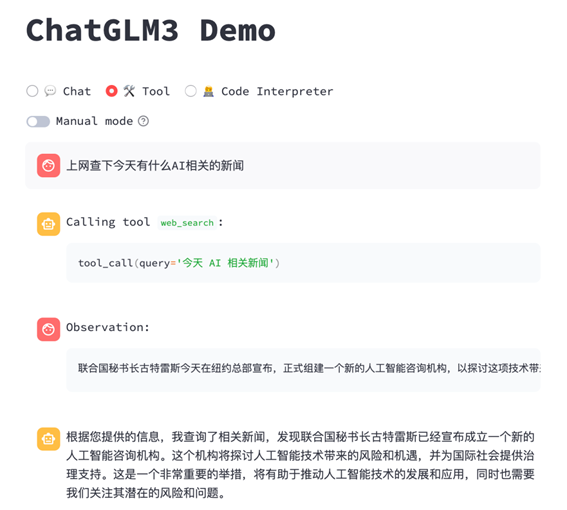ChatGLM3-6B 功能原理解析
发布时间:2024年06月06日
上次我们介绍了 ChatGLM3-6B 的部署,虽然我们的大语言模型(LLM)部署起来了,新功能也试用了,但问题很多的小明就要问了,这其中的实现原理是什么呢?到底是怎么实现的呢?那今天我们就再来介绍 ChatGLM3-6B 具体的功能原理,包括工具调用、代码解释器等。
添加自定义工具
在官方文档中,我们可以看到添加工具的说明:
可以通过在 tool_registry.py 中注册新的工具来增强模型的能力。只需要使用
@register_tool 装饰函数即可完成注册。对于工具声明,函数名称即为工具的名称,函数
docstring 即为工具的说明;对于工具的参数,使用 Annotated[typ: type,
description: str, required: bool] 标注参数的类型、描述和是否必须。
我们来尝试添加一个上网查询工具,这里我们使用SerpApi[1]来实现,SerpApi 是一个网络搜索 API,可以通过 API 来实现各种网络搜索,包括谷歌、百度、必应等。使用 SerpApi 首先需要在其官网注册一个账号,然后在个人设置中获取 API Key,这个 API Key 用于使用 SerpAPI 进行网络查询,再安装 SerpApi 的 python 库:pip install,然后就可以编写工具代码了。
google-search-results
我们在tool_registry.py中添加一个web_search工具:
@register_tooldefweb_search(
query:Annotated[str,'The query text to be queried',True],)->str:"""Search the result for input `query` from web"""
fromserpapiimportGoogleSearch
search=GoogleSearch({
"q":query,
"gl":"cn",
"location":"China",
"output":"json",
"api_key":"your serpapi api key"
})
try:
query_result=search.get_dict()
result=process_response(query_result)
returnresult
except:
importtraceback
ret="Error encountered while searching!\n"+traceback.format_exc()
在代码中,我们使用@register_tool标签注册工具,工具方法参数使用Anotated进行标注,然后再调用
SerpApi 的方法进行网络查询,其中的process_response方法是对查询结果进行解析,获取第一条查询结果提取内容并返回,具体实现可以参考 LangChain 的这个方法源码[2]。
添加完代码后,我们重启下 WebUI 服务,试用下新增的工具,查看运行结果:

使用 API 接口进行工具调用
我们再来看如何在 API 接口中使用工具调用,在 API 请求参数messages的每个元素中,除了role和content外,还新增metadata和tools参数,metadata是具体工具名称,tools是可以用到的所有工具列表,其实 ChatGLM3 是参考了 ChatGPT 的Function
Calling[3]功能,这 2 个参数分别对应
ChatGPT 的function_call和functions。
在初始请求中,我们需要传递tools参数,来告诉 LLM 有哪些工具可以使用,tools参数中每个元素有以下几个属性:
name:工具名称
description:工具描述
parameters:工具参数,包括参数的类型、参数的描述、是否必需(有 2 种格式,可以参考以下代码)
·
#格式1tools=[
{
"name":"get_weather",
"description":"Get the current weather for `city_name`",
"parameters":[
{
"name":"city_name",
"description":"The name of the city to be queried",
"type":"str",
"required":True
}
]
}]#格式2tools=[
{
"name":"get_weather",
"description":"Get the current weather for `city_name`",
"parameters":{
"type":"object",
"properties":{
"city_name":{
"description":"The name of the city to be queried"
}
},
"required":["city_name"]
}
}]
然后我们通过 python 代码发起 API 请求调用,这里需要安装一下 OpenAI 的 python 库:pip install openai。
importopenai#设置OpenAI参数openai.api_base="http://localhost:7861/v1"openai.api_key="xxx"system_info={
"role":"system",
"content":"Answer the following questions as best as you can. You have access to the following tools:",
"tools":tools,}messages=[
system_info,
{
"role":"user",
"content":"帮我查询北京的天气怎么样",
}]response=openai.ChatCompletion.create(
model="chatglm3",
messages=messages,
temperature=0,
return_function_call=True)
·
代码中我们将 OpenAI 的 API 地址换成本地的 ChatGLM3 API 地址,因为是调用本地的 LLM,所以无需填写 OpenAI 的
api_key,这里就随便写个字符串即可
填写 system 角色的提示词信息,需要将 tools 参数加进去
填写 user 角色的信息,这里就正常填写 role 和 content 参数就行
发起 ChatCompletion 请求,这里需要注意的是,需要将 model 设为chatglm3,同时加上 return_function_call 参数,设置为 true,这样才能让 LLM 去调用工具
将用户的初始请求发出去后,我们再来看如何进行工具调用:
fromjsonfromtool_registerimportdispatch_toolfunction_call=json.loads(response.choices[0].message.content)#这里返回`get_weather`工具的信息tool_response=dispatch_tool(function_call["name"],function_call["parameters"])messages=response.choices[0].history#获取历史对话信息messages.append(
{
"role":"observation",
"content":tool_response,#调用函数返回结果
})response=openai.ChatCompletion.create(
model="chatglm3",
messages=messages,
temperature=0,)print(response.choices[0].message.content)
LLM 根据用户的问题在工具集合中选择工具,这里选择了get_weather工具
使用dispatch_tool方法执行工具,dispatch_tool方法实现的方式很多,使用函数式编程的方式可以很方便地实现该功能
通过observation角色的对话信息将工具执行结果添加到历史对话中,相当将工具执行结果返回给 LLM
再次发起 ChatCompletion 请求,让 LLM 生成最终答案,最后打印出 LLM 生成的最终结果
这就是使用 API 调用工具的方法,更多细节可以参考官方源码[4]。
代码解释器
通过查看代码解释器的示例代码,发现其大概的流程是这样的:用户提出问题 --> LLM 生成代码 --> 提取生成的代码 --> 调用代码执行工具 --> 使用工具(Jupyter)执行代码 --> 提取(Jupyter)执行结果 --> 返回结果给用户。
ChatGLM3 在原有的 3 种角色(system、user、assistant)上增加了另外 3 个角色:observation、interpreter、tool:
# conversation.yclassRole(Enum):
def__str__(self):
matchself:
caseRole.SYSTEM:
return"<|system|>"
caseRole.USER:
return"<|user|>"
caseRole.ASSISTANT|Role.TOOL|Role.INTERPRETER:
return"<|assistant|>"
caseRole.OBSERVATION:
return"<|observation|>"
tool角色是工具调用,interpreter角色是代码解释器,observation角色是用来观察各种结果,包括 LLM 的输出、工具的返回结果、代码编辑器的执行结果等。我们再来看下代码编辑器具体的功能是如何实现的:
case'<|observation|>':
code=extract_code(output_text)
print("Code:",code)
display_text=output_text.split('interpreter')[-1].strip()
append_conversation(Conversation(
Role.INTERPRETER,
postprocess_text(display_text),
),history,markdown_placeholder)
message_placeholder=placeholder.chat_message(name="observation",avatar="user")
markdown_placeholder=message_placeholder.empty()
output_text=''
withmarkdown_placeholder:
withst.spinner('Executing code...'):
try:
res_type,res=execute(code,get_kernel())
exceptExceptionase:
st.error(f'Error when executing code: {e}')
return
print("Received:",res_type,res)
ifres_type=='text'andlen(res)>TRUNCATE_LENGTH:
res=res[:TRUNCATE_LENGTH]+' [TRUNCATED]'
append_conversation(Conversation(
Role.OBSERVATION,
'[Image]'ifres_type=='image'elsepostprocess_text(res),
tool=None,
image=resifres_type=='image'elseNone,
),history,markdown_placeholder)
message_placeholder=placeholder.chat_message(name="assistant",avatar="assistant")
markdown_placeholder=message_placeholder.empty()
output_text=''
break
从 LLM 的输出中通过extract_code方法提取代码,一般在 markdown 格式的文档中提取
再增加一个interpreter角色的对话记录,将代码显示在页面上
执行代码并获取执行结果,增加一个observation角色的对话记录,将执行结果返回给 LLM,LLM 再根据结果生成最终的答案,并将最终答案显示在页面上
下面是提取代码的功能,通过正则解析将 markdown 中的代码提取出来:
defextract_code(text:str)->str:
pattern=r'```([^\n]*)\n(.*?)```'
matches=re.findall(pattern,text,re.DOTALL)
returnmatches[-1][1]
更多的细节可以参考官网综合 Demo 的源码[5],如果在测试过程中遇到问题,也可以根据源码排查原因。
总结
其实 ChatGPT 之前就已经实现了工具调用和代码解释器的功能,但因为它是闭源的,我们无法窥视其中的原理,但 ChatGLM3 在开源产品的基础上实现了这些功能,让我们可以更好地理解其中的原理,也可以根据自己的需求进行二次开发,这也是开源的魅力所在。
出自:https://mp.weixin.qq.com/s/OSz0OcGhzsdqYPYHcgH2Jw


remove.bg 是一款强大的自动去除图片背景的在线工具,快速AI自动抠图!图片背景5秒消除,免费!